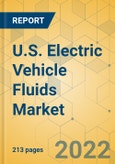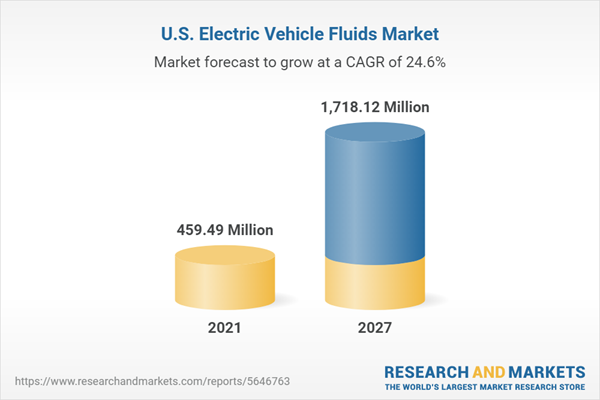Speak directly to the analyst to clarify any post sales queries you may have.
MARKET INSIGHTS
a) Electric Vehicle Fluids are lubricants for electric vehicles such as battery-powered or plug-in hybrids. These are formulated from high-quality synthetic base oils such as group IV and V.b) EV fluids perform various functions, including lubricating the transmission system, stabilizing the battery's temperature, cooling electric motors and gears, and reducing friction. In addition, it also provides insulation from electric current while enhancing the battery life. Therefore, electric vehicle fluids are specifically formulated to meet a broad range of performance requirements for electric vehicles.
c) The U.S. is the 3rd largest EV market and is growing very fast. The market in the country increased significantly from a few thousand to around 315,000 EVs from 2018 to 2020, as per International Council on Clean Transportation (ICCT). In 2020, the share of electric cars in new vehicle sales was around 2.4%, an increase from about 2.0% in 2019. Government policies are vital in reducing consumer barriers related to the scarcity of appropriate EV models, higher upfront costs, range-related issues, and lack of awareness.
FACTORS TO BE CONSIDERED WHILE FORMULATING EV FLUIDS:
- In the past, most EV OEMs used conventional lubricants to fulfill their requirement. However, most lubricant manufacturers have started providing EV-specific lubricants to most OEMs.
- Various categories and design differences in EVs to select appropriate lubricants.
- Fluids with lighter viscosities help maximize efficiency, anti-wear properties, and material compatibility with products such as adhesives, sealants, and others.
- Proper thermal management for battery systems in EVs
- The conductivity of the fluid relative to electric currents in EVs depends on the chemical additives and viscosity.
- Corrosion prevention in EVs as copper is used more than in conventional ICEs.
- Standards and regulations regarding the use and disposal of EV fluids in the United States.
MARKET TRENDS & OPPORTUNITIES
Rebates, Grants, and Subsidies to Promote EVs
Electric vehicles being environment-friendly, federal & state governments across the states are adopting several initiatives in tax rebates, bonuses, and subsidies to boost EV sales. For instance, under the Clean Vehicle Rebate Program, Delaware state is offering rebates to the EV owners or one who leases it. However, the number of rebates varies depending upon the type of EVs. For example, in the Delaware region, the reimbursement varies on customer purchases; USD 2,500 for a new BEV and up to USD 1,000 for a new PHEV.Electric vehicles run on battery and electric motor due to which it does not emits any hydrocarbon particulate, or carbon dioxide, thus resulting in significant reductions in greenhouse gas emissions and air pollution. Thus, with the continuous support of the US government, the demand for electric vehicles is rising, leading to a significant need for electric vehicle fluid.
Following are some of the rebates, tax credits, and grants offered by the US state & federal governments:
- Colorado offers a tax credit to all EV owners, including light-duty electric trucks, light-duty EVs, medium-duty electric trucks, and heavy-duty electric trucks.
- In Connecticut, the Connecticut Hydrogen and Electric Automobile Purchase Rebate Program (CHEAPR) offers rebates and incentives to EV owners who purchase or lease an electric vehicle from a licensed Connecticut automobile dealership.
- In Florida, the Orlando Utilities Commission (UCO) offers rebates of USD 200 to residential customers who purchase or lease a new EV. However, to avail of this rebate, the customer needs to apply within six months of the purchase or lease of the EVs.
Increasing Demand for Optimising Electric Vehicle Fluids
The integration of sophisticated components in EVs, such as high use of copper metals, availability of wide-bandgap semiconductors, high-performance traction motors that are exposed to high temperature and heat, and increased use of plastics in bearing cages in place of metals is leading to high demand for optimized lubricating fluids by EV.Original equipment manufacturers need to protect the vehicle’s critical components, such as coils, traction batteries, magnet wire insulation, and charging ports, from corrosion, high temperature, and breakdown of electrical components, thereby depending on electric vehicle fluids.
MARKET RESTRAINT
Shortage of Raw Material in the US Automotive Industry
Presently, the government electric vehicle segment is facing a shortage of semiconductor and lithium-ion batteries, but not to a great extent. After two to three years, the industry is expected to witness a substantial demand-supply imbalance for lithium-ion batteries, a crucial component of the electric vehicle. This is primarily because of the rapid increase in demand for electric vehicles in the US market and limited lithium-ion battery production, which is insufficient to meet the escalating demand. However, electric vehicle OEMs are encouraging mineral producers in terms of long contracts to mitigate this issue in the long run.SEGMENT ANALYSIS
The U.S. EV fluids market can be divided into four major segments: propulsion type, vehicle type, distribution channel, and product type.By propulsion: The U.S. electric vehicle fluids oil market is divided into segments by propulsion, battery electric vehicles, and plug-in hybrid batteries. During the projection period, battery electric vehicle fluid anticipates dominating the market and experiencing faster growth, mainly driven by the increased demand for battery-powered electric vehicles. The production of electric automobiles gets support from government initiatives to minimize carbon emissions. Henceforth, electric vehicle fluids are used instead of engine oil or other lubricants for the smooth functioning of the battery vehicle and to ensure its long life.
Segmentation by Propulsion
- Battery EV
- Plug-in Hybrid EV
For instance, the EPA and NHTSA suggested that the country implement the Safer Affordable Fuel-Efficient (SAFE) vehicles rule, which would go into effect between 2021 and 2026. This rule intends to establish minimum requirements for company average fuel efficiency and greenhouse gas emissions for both passenger and commercial vehicles, further fostering the growth of the U.S. electric fluids market.
Segmentation by Vehicle
- Commercial EV
- Passenger EV
- Others
Segmentation by Distribution
- OEMs
- Aftermarket
Segmentation by Product Type
- Heat Transfer Fluid
- Grease
- Transmission Fluid
- Brake Fluid
GEOGRAPHICAL ANALYSIS
The U.S. is a vital electric vehicle fluids market. The penetration of electric vehicle fluids is rising, and the market revenue has been increasing steadily. The country is a major hub for the consumption of electric vehicle fluid due to the strong demand from electric vehicle OEM manufacturers for high-quality lubricants driven by the rising demand for EVs in the U.S market.The western U.S. is the country's largest electric vehicle fluids market. In West U.S., the demand for electric vehicle fluids majorly comes from the electric vehicle production unit. Tesla, Chevrolet, and Toyota Motor Corporation are some of the EV players operating in the US West region and consume a significant chunk of electric vehicle fluids and drive the growth of the U.S. electric fluids market.
- The U.S.
- West
- California
- Washington
- Colorado
- South
- Texas
- Kentucky
- Northeast
- New York
- New Jersey
- Midwest
- Indiana
- Michigan
- Illinois
COMPETITIVE LANDSCAPE
The U.S. electric vehicle fluids market is experiencing an increase in competitiveness. Vendors may be adversely affected by the quickly evolving technical environment and the sustainability situation since customers anticipate constant improvements and innovations. Few companies dominate the industry and offer highly functional electric vehicle goods. Exxon Mobil Corporation, Phillips 66, GS Caltex, Idemitsu, and Valvoline are a few prominent players operating in the US electric vehicle fluids market.Recent Developments in the U.S. Electric Vehicle Fluids Market:
- In 2019, Exxon Mobil launched Mobil EV, a new fluid for electric vehicles.
- In March 2021, Phillips 66 launched an e-Shield product line for electric vehicles. It is a new product line, including coolants, grease, and system fluid.
- GS Caltex announced the launch of the Kixx EV lubricant for electric vehicles in June 2021. It offers a line of products, including E-Thermal fluid and E-Transmission fluids, that intend to improve the performance of electric vehicles and safeguard vital parts.
Key Vendors
- Exxon Mobil Corporation
- Valvoline
- GS Caltex
Other Prominent Vendors
- Phillips 66
- TotalEnergies
- Fuchs
- Shell
- Castrol
- Kluber Lubrication
- 3M
- Idemitsu Kosan Co., Ltd
FUTURE OUTLOOK
The U.S. market is significant in the global electric vehicle fluid market. The electric vehicle market is no longer at a nascent stage; instead, it is booming. Primarily due to the rising fuel cost, rising pollution levels, and the declining price of batteries.In addition, federal and state governments are implementing various policies to control the harmful emission from vehicles. Hence, OEMs prefer producing electric vehicles over internal combustion vehicles to meet that regulation. For instance, 15 states of the US and the District of Colombia have targeted to convert 30% of commercial HDVs (heavy-duty vehicles) to be ZEVs (zero emission vehicles) by 2030 and all HDVs vehicles by 2050.
KEY QUESTIONS ANSWERED:
1. What is the growth rate of the U.S. electric vehicle fluids market?2. What factors influence the growth of the U.S. electric vehicle fluids market?
3. What is the U.S. electric vehicle fluids market share expected value by 2027?
4. What are the different product types in the U.S. electric vehicle fluid market?
5. Who are the key vendors in the U.S. EV fluids market?
Table of Contents
Companies Mentioned
- Exxon Mobil Corporation
- Valvoline
- GS Caltex
- Phillips 66
- TotalEnergies
- Fuchs
- Shell
- Castrol
- Kluber Lubrication
- 3M
- Idemitsu Kosan Co., Ltd
Methodology
Our research comprises a mix of primary and secondary research. The secondary research sources that are typically referred to include, but are not limited to, company websites, annual reports, financial reports, company pipeline charts, broker reports, investor presentations and SEC filings, journals and conferences, internal proprietary databases, news articles, press releases, and webcasts specific to the companies operating in any given market.
Primary research involves email interactions with the industry participants across major geographies. The participants who typically take part in such a process include, but are not limited to, CEOs, VPs, business development managers, market intelligence managers, and national sales managers. We primarily rely on internal research work and internal databases that we have populated over the years. We cross-verify our secondary research findings with the primary respondents participating in the study.

LOADING...
Table Information
| Report Attribute | Details |
|---|---|
| No. of Pages | 213 |
| Published | August 2022 |
| Forecast Period | 2021 - 2027 |
| Estimated Market Value in 2021 | 459.49 Million |
| Forecasted Market Value by 2027 | 1718.12 Million |
| Compound Annual Growth Rate | 24.5% |
| Regions Covered | United States |
| No. of Companies Mentioned | 11 |









